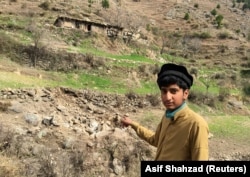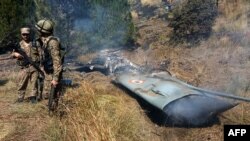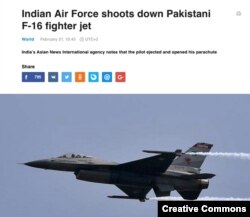On February 26, Indian jets launched a bombing raid on what it described as a militant training camp inside Pakistan. The air strike came in retaliation for a suicide attack in Indian-controlled Kashmir on February 14 that left 40 Indian servicemen dead.
Indian Foreign Secretary Vijay Gokhale announced the air strike had taken out "a very large number" of "terrorists, trainers, senior commanders, and groups of jihadis." Another Indian official claimed some 300 militants were killed in the bombardment.
But pictures taken by a Reuters photographer who visited the scene on February 28 show only craters on a sparsely populated hillside. A local told Reuters he was jolted awake by the predawn barrage but that no one was killed.
"Only some pine trees died, they were cut down. A crow also died."
Locals did tell Reuters that Jaish-e Muhammad, the extremist organization India said it was targeting, ran a madrasah, or Islamic religious school, near where the bombs struck. But that building appeared to be intact when Reuters visited.
Indian officials later walked back the tally of alleged "terrorist" deaths, saying on February 28 it was "premature" to provide casualty details.
Then, on February 27, as Pakistani and Indian jets clashed in the skies above Kashmir, officials made contrasting claims. Pakistani Prime Minister Imran Khan announced his military had shot down two Indian warplanes and captured two pilots.
In Delhi, meanwhile, a government spokesperson told reporters the Indian Air Force had shot down a Pakistani fighter plane and lost one of its own aircraft and pilots in the clash. A senior Indian Air Force officer then claimed the downed Pakistani jet was an F-16 taken down by an Indian MiG-21.
Soon afterward, photos and videos were released that confirmed one Indian pilot had been captured and an Indian MiG-21 jet had been downed, but no evidence that a second Indian plane or a Pakistani plane was shot down has since emerged.
The downing of a relatively modern F-16 fighter by an Indian Air Force MiG-21, which first took to the skies in 1959, might be a surprising takedown given the disparity in technology of the planes. And several media outlets have run with the David-and-Goliath angle of an ancient Soviet jet taking out a relatively modern American-made F-16.
Lynette Nusbacher, a strategist and former British intelligence officer, told RFE/RL that such a shoot-down is certainly possible "if the right missile or round hits [an F-16], it doesn't matter what platform the missile or round comes comes from." But Nusbacher said there was not enough open-source evidence available to say whether an F-16 had indeed been shot down.
Since the announcement that a Pakistani F-16 was downed, amateur sleuths have trawled the Internet for proof of an F-16's demise, with many major Indian news outlets basing reports on images that appear to show the downed Indian MiG, rather than a Pakistani F-16.
Further confusion followed when an Indian military helicopter crashed in Kashmir on the morning of February 27, reportedly killing several servicemen. Several major news outlets included images of the helicopter crash to illustrate the stories of downed "planes" during the crisis. The British outlet The Independent described several pictures of the helicopter wreckage, including one photo that clearly shows a helicopter rotor, as the remains of "an Indian fighter jet."












